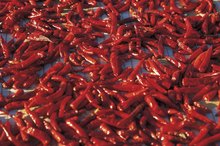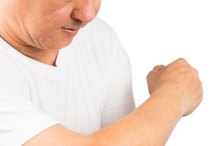How to Remove Capsaicin From Skin
Capsaicin is a medication, available over the counter and with a prescription, that helps relieve pain associated with shingles, rheumatoid arthritis and muscle sprains. Available as a topical patch, cream or ointment, capsaicin is also the same substance that makes chili peppers hot. This medication relieves pain by heating the painful area of your body, reducing the amount of pain messenger chemicals in that area. Knowing how to remove capsaicin from your skin is important to reduce risk of irritation, remove the product from your hands after application to other parts of your body and remove residual medication from a capsaicin patch.
If you are experiencing serious medical symptoms, seek emergency treatment immediately.
Wash hands with soap and water after applying the medication to affected areas of your body. If the hands are the affected area, wait at least 30 minutes prior to washing them so the medication has time to absorb into your skin. To reduce skin irritation after application, wash off the medication with warm water and mild soap 3. Do not use hot water since it can heat up the capsaicin and cause further irritation.
How to Thin Compound W
Learn More
Avoid touching sensitive areas of your body after applying capsaicin to your hands. The chemical can burn delicate areas, such as your eyes. Flush sensitive areas with warm water and use a mild soap to remove the remaining capsaicin. Avoid touching items such as dentures, contact lenses and food with capsaicin on your hands.
Use the supplied cleaning gel after removing a capsaicin patch 4. Apply the gel to the entire area previously covered by the patch and wait for at least one minute. Wipe the area clean with a dry cloth before using a mild soap and water to wash the area. Dry your skin completely with a towel.
Warnings
Contact a physician for irritation and discomfort caused by using capsaicin.
Related Articles
References
- Pharmacological Reviews: Unravelling the Mystery of Capsaicin -- A Tool to Understand and Treat Pain
- British Journal of Anaesthesia: Topical Capsaicin for Pain Management -- Therapeutic Potential and Mechanisms of Action of the New High-Concentration Capsaicin 8% Patch
- Pain Medicine News Special Edition: Topical Medications in the Treatment of Pain
- University of Maryland Medical Center: Capsaicin (On the Skin)
- Fattori V, Hohmann MS, Rossaneis AC, Pinho-ribeiro FA, Verri WA. Capsaicin: current understanding of its mechanisms and therapy of pain and other pre-clinical and clinical uses. Molecules. 2016;21(7). doi:10.3390/molecules21070844
- Derry S, Moore RA. Topical capsaicin (low concentration) for chronic neuropathic pain in adults. Cochrane Database Syst Rev. 2012 Sep 12;(9):CD010111. doi:10.1002/14651858.CD010111
- McAlindon TE, Bannuru RR, Sullivan MC, et al. OARSI guidelines for the non-surgical management of knee osteoarthritis. Osteoarthritis Cartilage. 2014 Mar;22(3):363-88. doi:10.1016/j.joca.2014.01.003
- Gagnier JJ, Oltean H, van Tulder MW, Berman BM, Bombardier C, Robbins CB. Herbal medicine for low back pain: A Cochrane review. Spine (Phila Pa 1976). 2016 Jan;41(2):116-33. doi:10.1097/01.brs.0000249525.70011.fe
- Siemens W, Xander C, Meerpohl JJ, et al. Pharmacological interventions for pruritus in adult palliative care patients. Cochrane Database Syst Rev. 2016;11(11):CD008320. doi:10.1002/14651858.CD008320.pub3
- Moon AM, Buckley SA, Mark NM. Successful treatment of cannabinoid hyperemesis syndrome with topical capsaicin. ACG Case Rep J. 2018;5:e3. doi:10.14309/crj.2018.3
- Carey ET, As-Sanie S. New developments in the pharmacotherapy of neuropathic chronic pelvic pain. Future Sci OA. 2016;2(4):FSO148. doi:10.4155/fsoa-2016-0048
- McMillan R, Forssell H, Buchanan JA, Glenny AM, Weldon JC, Zakrzewska JM. Interventions for treating burning mouth syndrome. Cochrane Database Syst Rev. 2016;11(11):CD002779. doi:10.1002/14651858.CD002779.pub3
- Loflin BJ, Westmoreland K, Williams NT. Vulvodynia: A review of the literature. J Pharm Technol. 2019;35(1):11-24. doi:10.1177/8755122518793256
- Derry S, Rice AS, Cole P, Tan T, Moore RA. Topical capsaicin (high concentration) for chronic neuropathic pain in adults. Cochrane Database Syst Rev. 2017;1:CD007393. doi:10.1002/14651858.CD007393.pub4
- Baranidharan G, Das S, Bhaskar A. A review of the high-concentration capsaicin patch and experience in its use in the management of neuropathic pain. Ther Adv Neurol Disord. 2013;6(5):287-97. doi:10.1177/1756285613496862
Writer Bio
Abigail Adams began her freelance writing career in 2009, teaching others about medical conditions and promoting wellness by writing on online health and fitness publications. She is educated and licensed as a registered nurse, having received her degree from North Georgia College and State University.









